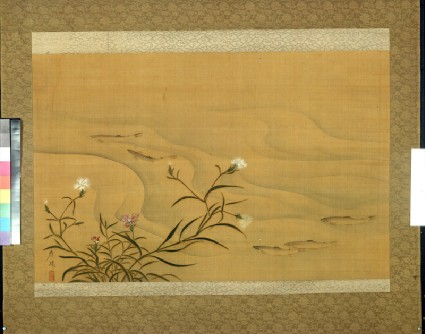Browse: 10610 objects
- Reference URL
Actions
Sweetfish in a stream with pinks on the shore
-
Details
- Associated place
-
Asia › Japan › Honshū › Kyōto prefecture › Kyoto (possible place of creation)
- Date
- 1789 - 1800
- Artist/maker
-
Maruyama Ōzui (1776 - 1829) (artist)Maruyama-Shijō School (active late 18th century - late 19th century)
- Material and technique
- ink and colour on silk
- Dimensions
- 37 x 57.5 cm (height x width)
- Material index
-
organic › animal › animal product › silk,
- Technique index
- Object type index
- No. of items
- 1
- Credit line
- Purchased with the assistance of the Friends of the Ashmolean, and Mr and Mrs J. Hillier, 1973.
- Accession no.
- EA1973.156
-
Further reading
Katz, Janice, Japanese Paintings in the Ashmolean Museum, Oxford, with an introductory essay by Oliver Impey (Oxford: Ashmolean Museum, 2003), no. 19 on pp. 86-87, p. 83, illus. pp. 86-87
Location
-
- currently in research collection
Objects are sometimes moved to a different location. Our object location data is usually updated on a monthly basis. Contact the Jameel Study Centre if you are planning to visit the museum to see a particular object on display, or would like to arrange an appointment to see an object in our reserve collections.
Publications online
-

Japanese Paintings in the Ashmolean Museum
This image of a school of ayu (sweetfish) swimming in the shallow water shows Ōzui’s reliance on Maruyama school sketches from life, or shasei [the pinks of this painting are very similar to an album leaf by Kinoshita Ōju that has been separated from its album in the Yamato Bunkakan entitled Album of a Gathering held at Daiichirō, Higashiyama published in Kobayashi Tadashi and Kōno Motoaki, Ōkyo, Rosetsu, Jakuchū: Maruyama-Shijō ha (Ōkyo, Rosetsu, Jakuchū: Maruyama-Shijō school), Edo meisaku gachō zenshū (Masterpieces of painted albums from the Edo period), vol. 7 (Tokyo, Osaka: Shinshindō, 1996), 151. This points to a shared model being used among Ōkyo’s followers]. 'Five ayu swim under waves painted with a light wash of blue pigment. The pinks in the foreground, by contrast, are done with bright white and pink pigment, and a few flowers are articulated with a very sharp dark outline.
The Ashmolean’s painting is very similar in style to Ōzui’s pair of six-fold screens of Birds and Flowers of the Four Seasons in Daishōji temple, in which a school of ayu is seen swimming in a stream beyond the flowers. The addition of small fish to the composition, not a traditional element, shows Ōzui’s creativity in incorporating his father’s sketches into finished works. In addition, both works share the same controlled brushwork and carefully detailed depictions of flowers [published in Minamoto Toyomune and Sasaki Jōhei, eds, Kyoto gadan no jūkyūseiki, vol. 2 Bunka Bunseiki (Kyoto: Shibunkaku shuppan, 1994) 22-23].
Maruyama Ōzui was the eldest son of Ōkyo and became head of the school after his father died in 1795. He is known primarily for faithfully continuing the style of his father, and for keeping the school's circle of artists and compositional models assembled. Around the same time as his father's death, other prominent artists of the Maruyama school passed away, such as Komai Genki (1747-1797) and Nagasawa Rosetsu (1754-1799) (who had been expelled from the studio some years before). In this turbulent period in the school’s existence, Maruyama school artists would meet once a month at Ōzui’s house to show their paintings and discuss them [Kimura Shigekazu, Maruyama-ha nidaime: Ōzui, in ibid., 147].
© 2013 University of Oxford - Ashmolean Museum

